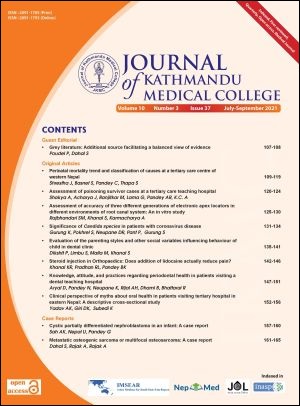Steroid injection in Orthopaedics: Does addition of lidocaine actually reduce pain?
DOI:
https://doi.org/10.3126/jkmc.v10i3.41238Keywords:
Corticosteroid, Intralesional injection, Lidocaine, Local anaesthetic, Visual analogue scaleAbstract
Background: Local corticosteroid preparations are conventionally mixed with local anaesthetic agents to reduce pain during injection for various soft tissue affections in Orthopaedics. Although it can anaesthetise the area after injection, the infiltration process itself can be more painful because of low pH of the lidocaine.
Objectives: To assess whether addition of lidocaine actually reduces pain during local steroid injection.
Methods: This was a prospective comparative study conducted at Kathmandu Medical College over a period of nine months from June 2020 to February 2021 after obtaining ethical clearance. Patients requiring local corticosteroid injection for various indications in Orthopaedics were included by convenience sampling and divided into two groups. Out of 147 patients, 75 received steroid with lidocaine and 72 with normal saline. The Visual Analogue Score was recorded immediately along with injection in a scale of 0 to 10 where 0 meant no pain at all and 10 meant maximum pain imaginable. The difference in median Visual Analogue Score and the mean cost of injection between two groups was compared. Findings were analysed using SPSS v.20.
Results: Median Visual Analogue Score in lidocaine group was 5 whereas in normal saline group was 4 (p-value = 0.33, Mann-Whitney U test). The mean cost of injection in lidocaine and normal saline groups were Nepali Rupees 339.3 ± 37.7 and 282.3 ± 36.7 respectively (p <0.001, Student’s t-test)
Conclusion: Removal of lidocaine from steroid preparations in orthopaedics does not make it more painful if not less. It also reduces the cost of injection.
Downloads
Downloads
Published
How to Cite
Issue
Section
License
Copyright © Journal of Kathmandu Medical College
The ideas and opinions expressed by authors or articles summarized, quoted, or published in full text in this journal represent only the opinions of the authors and do not necessarily reflect the official policy of Journal of Kathmandu Medical College or the institute with which the author(s) is/are affiliated, unless so specified.
Authors convey all copyright ownership, including any and all rights incidental thereto, exclusively to JKMC, in the event that such work is published by JKMC. JKMC shall own the work, including 1) copyright; 2) the right to grant permission to republish the article in whole or in part, with or without fee; 3) the right to produce preprints or reprints and translate into languages other than English for sale or free distribution; and 4) the right to republish the work in a collection of articles in any other mechanical or electronic format.




